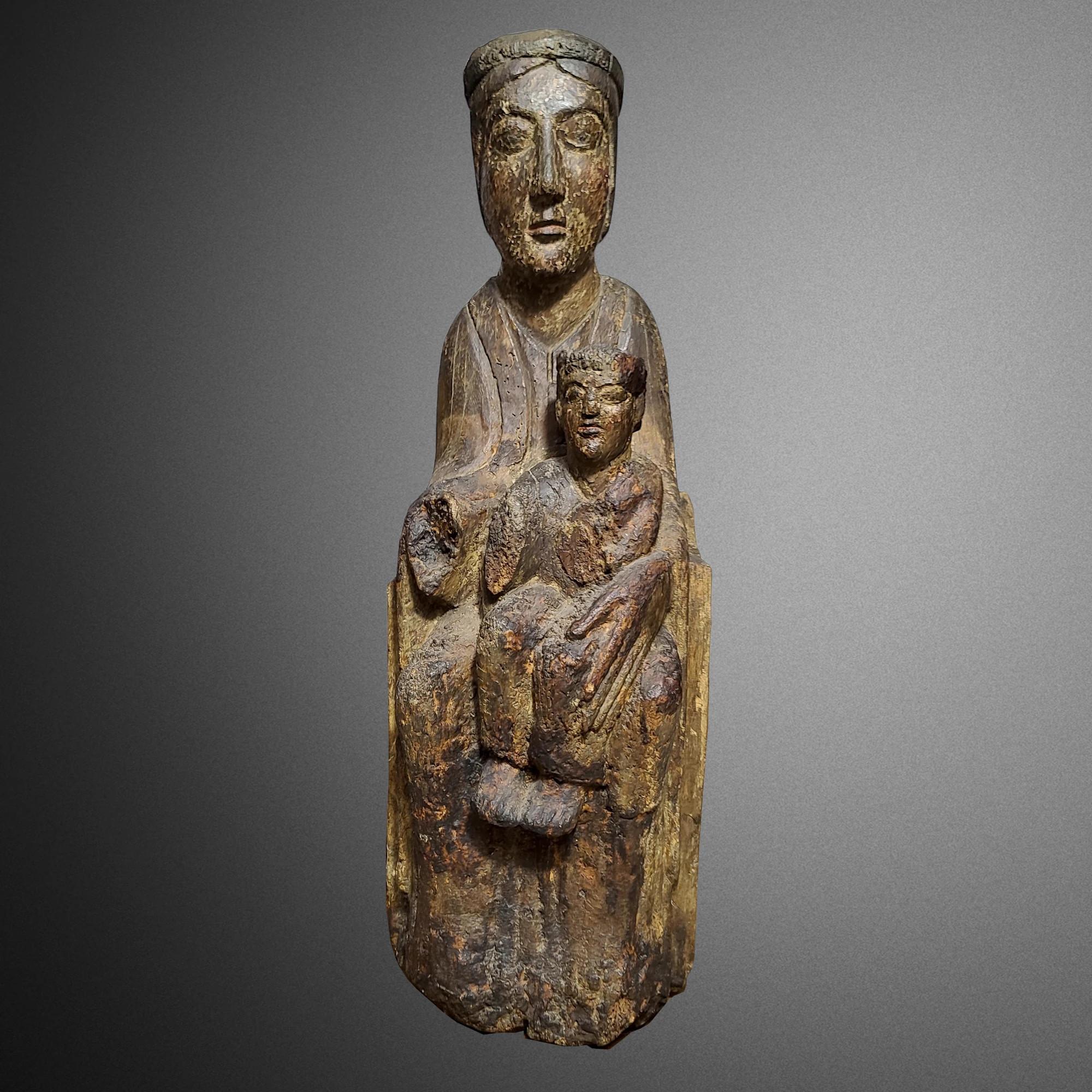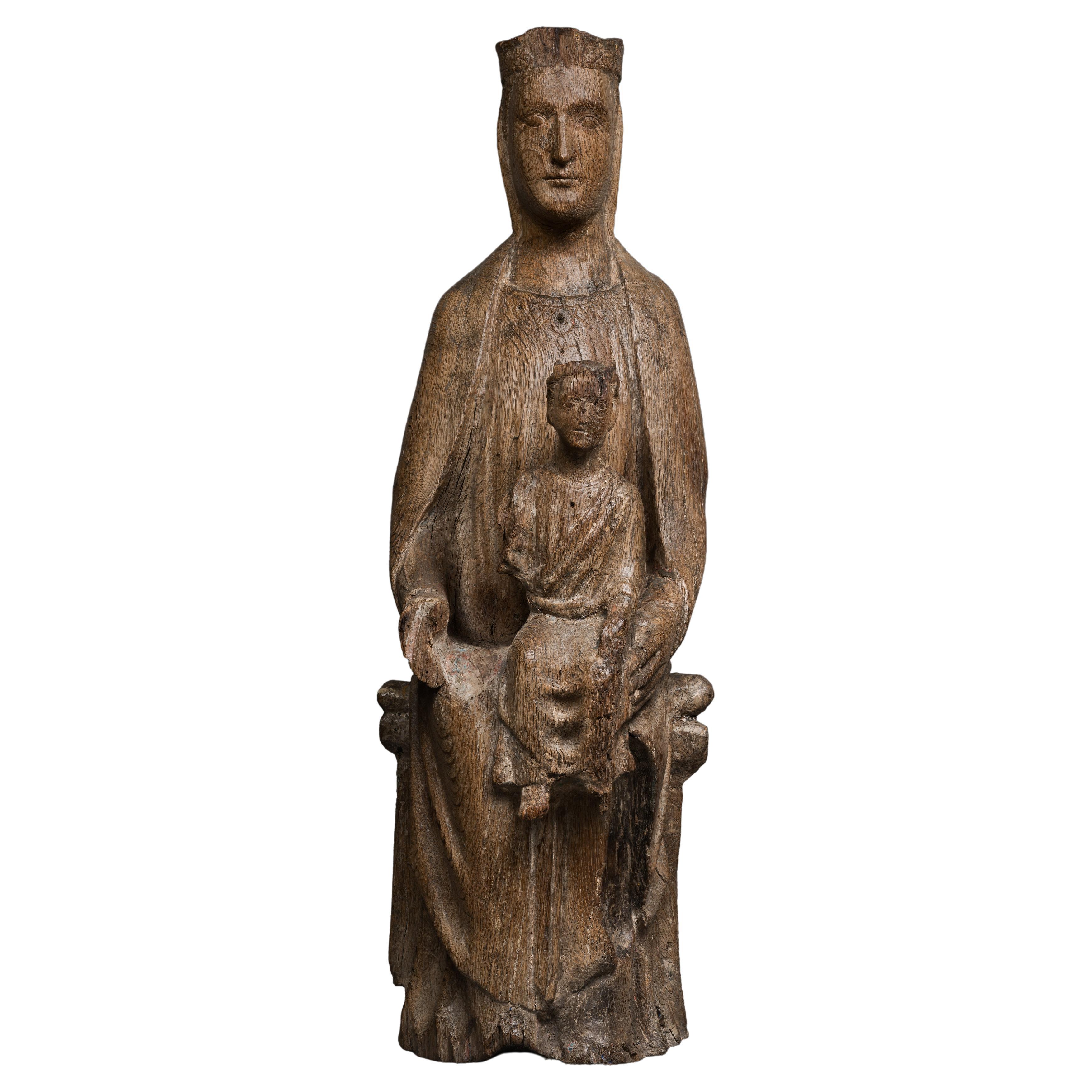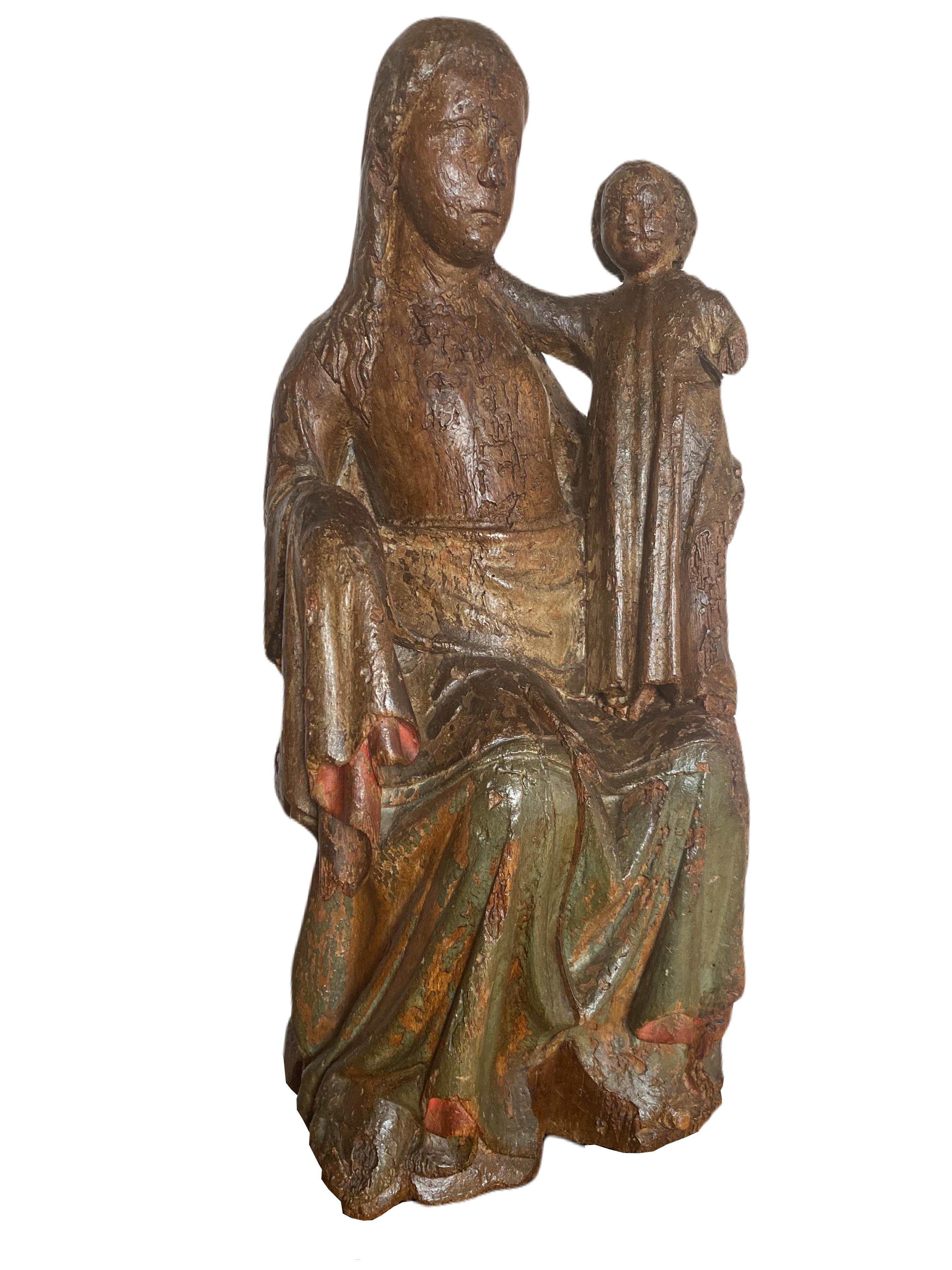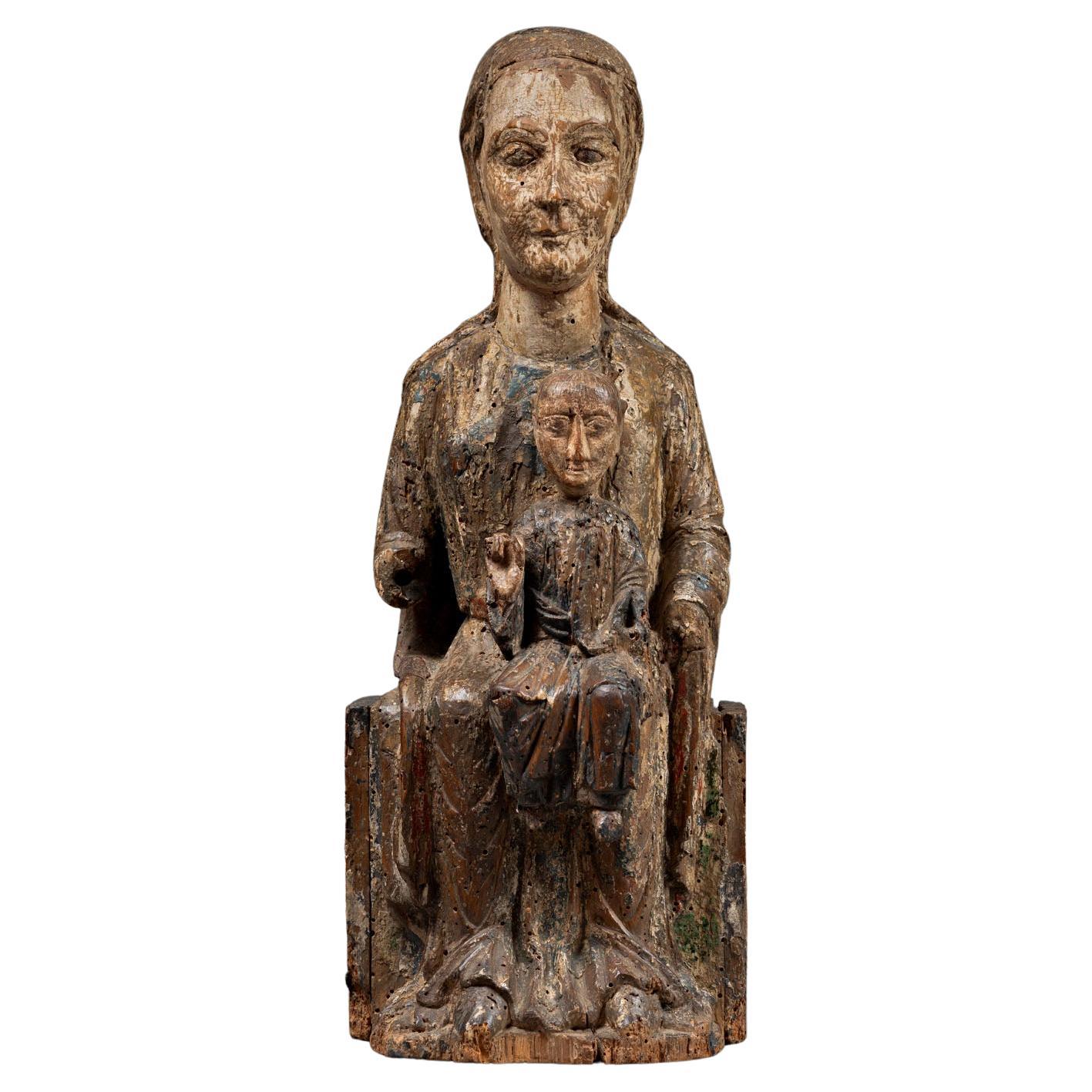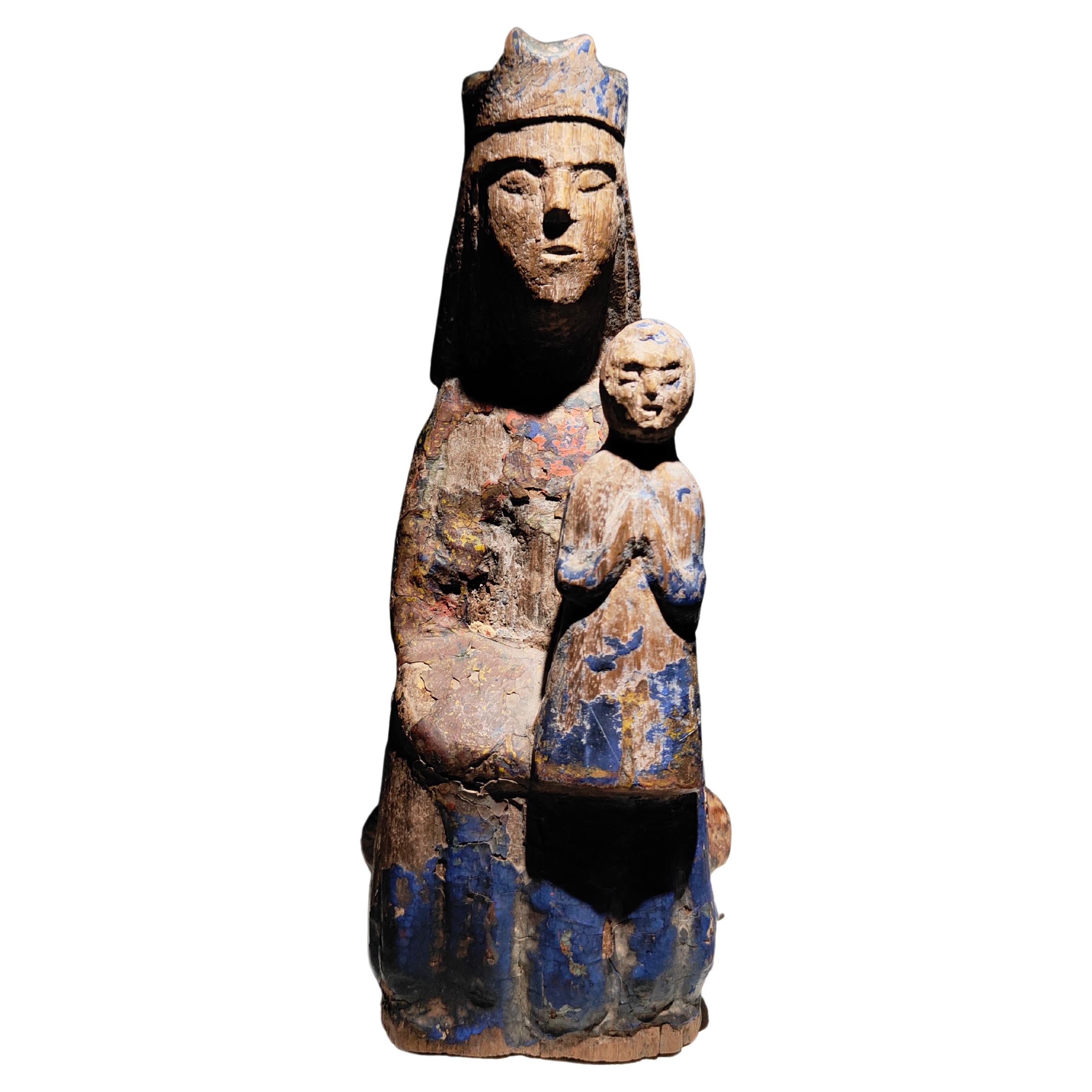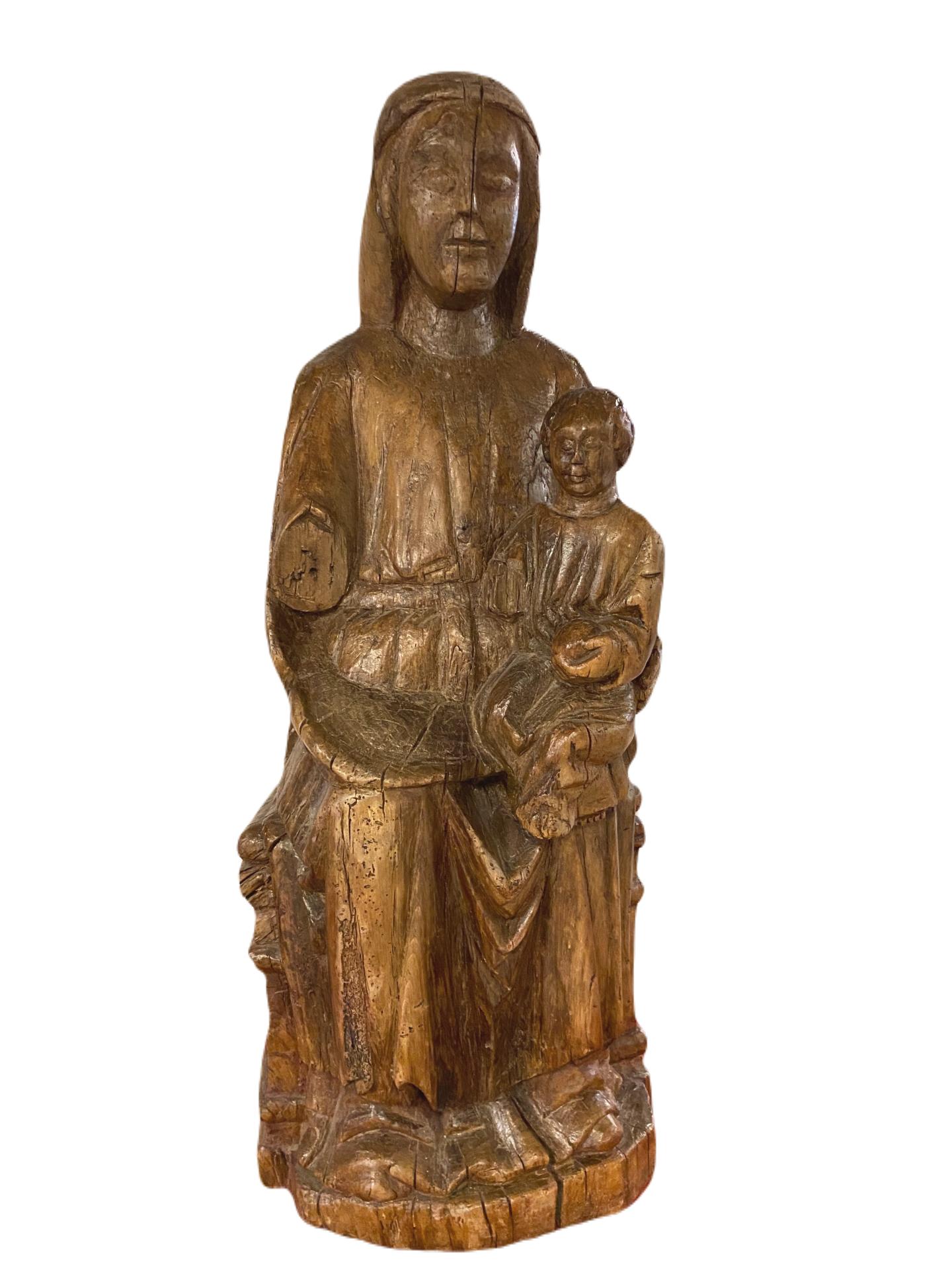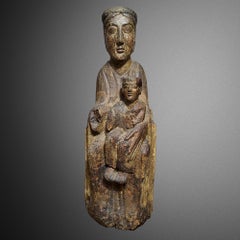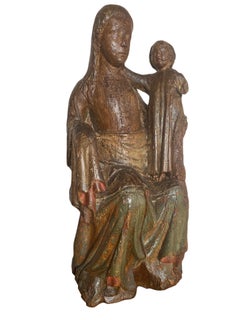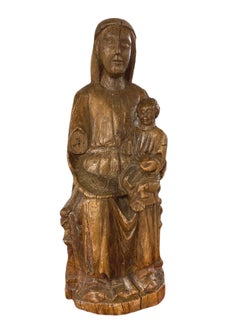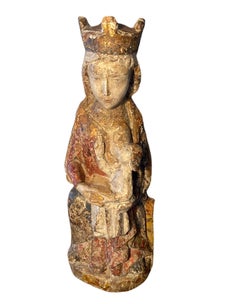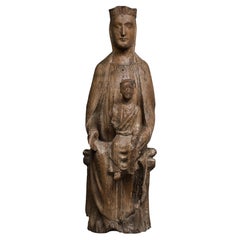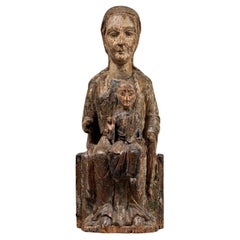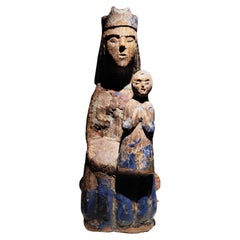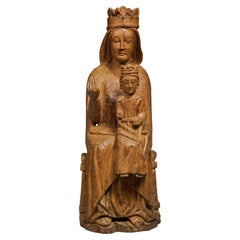Items Similar to Vierge en majesté assise romane. Sedes Sapientiae.
Want more images or videos?
Request additional images or videos from the seller
1 of 6
UnknownVierge en majesté assise romane. Sedes Sapientiae.Circa 1150
Circa 1150
$106,558.05
£79,278.12
€89,000
CA$148,457.21
A$161,577.70
CHF 84,826.81
MX$1,952,094.47
NOK 1,064,670.50
SEK 1,003,858.35
DKK 677,664.55
About the Item
Rare Vierge romane en majesté en pierre calcaire sculptée en très haut-relief. La Vierge tient l’Enfant entre ses deux genoux dans une parfaite frontalité, une caractéristique des premières vierges romanes dites Sedes Sapientiae. Marie est ceinte d'une couronne ornée de cabochons rectangulaires et losangés, son visage en ovale allongé avec pommettes et globes oculaires saillants. Le trône, de belle qualité d’exécution, présente des accotoirs pleins à deux arcatures reposant sur des colonnettes romanes cylindriques baguées à base moulurée. Le Christ est représenté avec des traits âgés rappelant l’antériorité du Christ sur la Vierge. Il adopte la même attitude que Marie, une bandoulière en diagonale sur sa poitrine. Si des parallèles existent avec les vierges romanes auvergnates, le style plus raffiné des personnages et du trône, l'analyse géologique du calcaire nous amènent à placer cette sculpture en Bourgogne, Champagne ou Lorraine, dans la seconde moitié du XIIe siècle.
Les Vierges romanes en pierre sont rares, et conservées pour la plupart dans les monuments (Mozac, Perse, Bonneval, Vinnac, Corneilla-de-Conflent) ou dans les collections des musées tels que le Louvre (Vierges provenant de Crespière et de Chartes). Notre sculpture provient d'un tympan d'église romane. Ce calcaire blanc peut provenir des formations du Jurassique supérieur du nord de la Bourgogne, Tonnerre et Auxerrois. Manques visibles.
- Creation Year:Circa 1150
- Dimensions:Height: 23.23 in (59 cm)Width: 8.67 in (22 cm)Depth: 7.49 in (19 cm)
- Medium:
- Movement & Style:
- Period:
- Condition:
- Gallery Location:PARIS, FR
- Reference Number:Seller: 2321stDibs: LU1858215918272
About the Seller
No Reviews Yet
Vetted Professional Seller
Every seller passes strict standards for authenticity and reliability
Established in 2021
1stDibs seller since 2022
5 sales on 1stDibs
- ShippingRetrieving quote...Shipping from: PARIS, France
- Return Policy
Authenticity Guarantee
In the unlikely event there’s an issue with an item’s authenticity, contact us within 1 year for a full refund. DetailsMoney-Back Guarantee
If your item is not as described, is damaged in transit, or does not arrive, contact us within 7 days for a full refund. Details24-Hour Cancellation
You have a 24-hour grace period in which to reconsider your purchase, with no questions asked.Vetted Professional Sellers
Our world-class sellers must adhere to strict standards for service and quality, maintaining the integrity of our listings.Price-Match Guarantee
If you find that a seller listed the same item for a lower price elsewhere, we’ll match it.Trusted Global Delivery
Our best-in-class carrier network provides specialized shipping options worldwide, including custom delivery.More From This Seller
View AllVierge romane en majesté. Bourgogne 12ème siecle.
Located in PARIS, FR
Grande vierge en majesté de l'époque romane en bois polychrome. Cette Vierge à l'enfant inédite s'inscrit dans le corpus des Vierges romanes de Bourgogne. Marie est assise sur un trô...
Category
15th Century and Earlier Medieval Figurative Sculptures
Materials
Wood
Vierge en majesté mosane. Sedes Sapientiae.
Located in PARIS, FR
Grande Vierge à l'Enfant en chêne de la fin du 13ème siècle ou début du 14ème siècle. La plastique des visages et du Christ évoque le 13ème siècle (le visage de la Vierge évoque le visage de la Sedes Sapientiae...
Category
15th Century and Earlier Gothic Figurative Sculptures
Materials
Wood
Enthroned Madonna and Child.
Located in PARIS, FR
Large Virgin and Child in carved wood, carved back. Sitting on a throne bench, Mary carries Christ seated on her left knee. The Virgin has a face with stylized features with semicircular eyebrow arches, almond-shaped eyes with protruding eyeballs. Marie is wearing a belted dress with a simple neckline and a coat with a flap that goes back to the front. Tiny traces of polychromy.
Romanesque influences are still present. With her protruding eyes, she can also be compared to the statuary of Lake Constance. Our Virgin, rare for its size, nevertheless presents strong analogies with the Italian Sedes Sapientiae...
Category
15th Century and Earlier Medieval Figurative Sculptures
Materials
Wood
Vierge en majesté. Catalogne française - Maria Lactans
Located in PARIS, FR
Rare Vierge à l'Enfant en bois polychrome de tradition romane, région du Fenouillèdes, représentant une Virgo Lactans. Avant cette découverte, seules 3 vierges allaitantes médiévales...
Category
15th Century and Earlier Gothic Figurative Sculptures
Materials
Wood
Polychrome Virgin of the Annunciation - Catalonia
Located in PARIS, FR
Large catalan Virgin of the Annunciation in polychrome wood. Our Virgin is represented in the phase of the Conturbatio, Mary expresses her amazement a...
Category
15th Century and Earlier Gothic Figurative Sculptures
Materials
Wood
Catalan School of the 13th century. Wooden Bishop
Located in PARIS, FR
Catalan School of the 13th century. Bishop statue in polychrome wood.
Large polychrome wooden statue representing a holy bishop carrying a crosier and ma...
Category
15th Century and Earlier Medieval Figurative Sculptures
Materials
Wood
You May Also Like
Important Sedes Sapientiae Virgin and Child also called "Throne of Wisdom"
Located in Saint-Ouen, FR
IMPORTANT SEDES SAPIENTIAE VIRGIN AND CHILD
ALSO CALLED « THRONE OF WISDOM »
ORIGIN: FRANCE, BURGUNDY
PERIOD: EARLY 13th CENTURY
Height : 75 cm
Len...
Category
Antique 15th Century and Earlier Figurative Sculptures
Materials
Oak
Exceptional Virgin and Child in Majesty or "Sedes Sapientiae", Throne of Wisdom
Located in Saint-Ouen, FR
Exceptional virgin and child in majesty
or “Sedes Sapientiae”, throne of wisdom
Origin: southwestern France.
Period: late 12th - early 13th cen...
Category
Antique 15th Century and Earlier Figurative Sculptures
Materials
Walnut
Seated Virgin with Child (Sedes Sapientiae) from the 12th Century in Spain
Located in Madrid, ES
Technique: Tempera and oil on wood
Dimensions: 25 x 11 x 8 cm
Description:
This exceptional work from the 12th century represents the Seated Virgin with Child (Sedes Sapientiae), standing out as an artistic treasure from medieval Spain. The portrayal of the Virgin enthroned with the Child on her lap is emblematic of Romanesque art, and this particular piece is a valuable and authentic example of that era.
The current polychromy belongs to the Gothic period and overlays the original Romanesque layer. It is crucial to highlight that the current state of the artwork is the original, without any cleaning interventions, imparting a unique authenticity.
The work exhibits architectural characteristics typical of Romanesque art, evident in the sides of the throne. The rigidity and symmetry characteristic of this style are reflected in the firm presentation of the Baby Jesus, noticeable in his gesture while holding his son. The Virgin wears a crown, symbolizing her royal character as the Queen of Heaven and Creation. Both figures retain traces of polychromy on the face and attire, adding layers of history and authenticity.
While similar Romanesque Virgin...
Category
Antique 15th Century and Earlier Figurative Sculptures
Materials
Fruitwood
Virgin and Child in Majesty, also known as "Sedes Sapientae"
Located in Saint-Ouen, FR
VIRGIN AND CHILD IN MAJESTY, ALSO KNOWN AS "SEDES SAPIENTIAE"
ORIGIN : SPAIN, CATALOGNE
PERIOD: EARLY 13th CENTURY
Height : 95 cm
Width : 32 cm
Depth : 28 cm
Softwood
No polychromy
In the middle of the 12th century, the Virgin took her place in churches, seated in Majesty, serving as a throne for her son Jesus. She is then called Sedes Sapientiae, meaning the Throne of Wisdom.
At that time, she is not represented for herself and only exists because she has been designated as Theotokos, the mother of God, at the Council of Ephesus in 431, where the divine nature of Christ was proclaimed from his birth.
The upright and perfectly hieratic bust of this Virgin and Child in Majesty is seated on a throne-bench. She is dressed in a tunic with a rounded neckline and covered with a fine mantle placed on her narrow shoulders. The supple and natural drapery follows the lines of the body.
Large curls frame her face with delicate and regular features, a long straight nose, almond-shaped eyes, and small lips.
She supports the Infant Jesus with her left hand. Like his mother, he is dressed in a long tunic, and his little feet are visible in the folds. He holds a small sphere in his left hand, while with his right hand, he gestures in blessing. The face of Christ bears a strong resemblance to his mother’s one, and he gives a slight smile.
The position of the Child is no longer as hieratic, nor frontal or central as in the early 12th century, but his face still turns towards the faithful.
The 13th century indeed emerges as a period of transition in the artistic domain. The statuary, while retaining certain characteristics still belonging to the habits of the previous century, also develops new formal solutions.
As a result, Mary maintains a hieratic and frontal position, while her son shifts to place himself well to the left on her knee. Similarly, while the Virgin seems perfectly still, Jesus, on the other hand, appears much more animated, especially in the positioning of his hands. His left hand holds the orb, and judging by the raised right arm directed towards the faithful, one can easily imagine that he was making a gesture of blessing.
The influence of the Sedes Sapientiae from previous centuries still seems particularly prevalent in this work.
These few characteristics allow dating this Spanish Virgin...
Category
Antique 15th Century and Earlier Spanish Gothic Figurative Sculptures
Materials
Softwood
Medieval enthroned Virgin and Child Sedes Sapientiae acephalic granit sculpture
Located in Norwich, GB
They may be damaged and battered, but real historic objects will always give you a sense of awe. Can you sense it, looking at this ancient carved granite which depicts, as it is call...
Category
15th Century and Earlier Medieval Figurative Sculptures
Materials
Granite
Important Virgin and Child in Majesty
Located in Saint-Ouen, FR
Important virgin and child in majesty
Origin : Germany Or Eastern France
Époque : Second Half Of The 13th Century
Height: 104.5 cm
Length: 3...
Category
Antique 15th Century and Earlier Figurative Sculptures
Materials
Oak
More Ways To Browse
Antique Black Limestone
Torso Of Hermes
Trois Sardines
Van Gogh Bust
Vincent Glinsky Sculpture
Vincent Glinsky
Virgen De La Caridad Del Cobre
Wendy Saxon Brown
Wesley Fleming
Willem Degroot
William Debilzan
William Morris Glass Art
Winged Hat Hermes
Wladimiro Politano
3 Wise Monkeys
A Moreau Angels
Alex Katz Cut Out
Alexis Silk Glass
